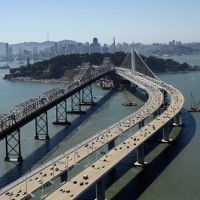Cracked Rods on Bay Bridge Called a “Portent of Catastrophe”
 New Bay Bridge, on the right (photo: Ezra Shaw, Getty Images)
New Bay Bridge, on the right (photo: Ezra Shaw, Getty Images)
Robert Bea, the “Master of Disaster,” cited a fundamental engineering principal last year when complaining about the $6.4-billion re-constructed San Francisco-Oakland Bay Bridge: They did not “engineer explicitly for repairability.”
That could be a problem.
Chief engineer for the California Department of Transportation (Caltrans), Brian Maroney, said this week that tiny new cracks in two of the bridge's tower rods mean they have to assume the cracks exist in every rod. There are 400 of them. He told a bridge oversight panel in Oakland that they may have to be modified, repaired or replaced.
Caltrans has been making bridge fixes since before the new bridge span opened in September 2013, replacing giant support rods and plugging leaks, but stopping short of recognizing a systemic problem that could prove costly, if not impossible, to fix. Thirty-two rods broke during a stress test in April of that year, prompting talk of “hydrogen embrittlement” and “quality-control failure.”
The Sacramento Bee said the new cracks indicate the problem could be foundational and inaccessible and could have been addressed two years ago, when they were discovered. It was looking good for the rods just a month ago when seismic stress tests turned up just one bad one.
The problem is water. It shouldn't be sloshing about in spaces around the rods. At first, the dampness was blamed on poor grouting, rainwater or wash water from above. That's not good, but not as bad as corrosive saltwater leaking in through the foundation cap below. It causes microcracks and makes steel rods brittle.
Almost all of the rods have gotten wet and a fourth of them regularly get soaked.
One does not have to be a forensic engineer like Bea to intuit that does not bode well for performance in an earthquake. The bridge was designed as a critical transit connector for San Francisco in case of disaster. It was also designed to last 150 years.
Berkeley engineer Lisa Fulton, a corrosion expert, told the San Francisco Chronicle the new cracks mean, “We don’t need an earthquake for them to snap . . . they are unreliable in the service loads that they are under now. The micro-cracking is a sure sign of hydrogen attack. It’s a portent of catastrophe.”
–Ken Broder
To Learn More:
Ominous New Cracks Found on Bay Bridge Rods (by Michael Cabanatuan and Jaxon Van Derbeken, San Francisco Chronicle)
Bay Bridge Tower Bolts Could Be Replaced, Engineer Says (by Andrew McGall, Oakland Tribune)
Caltrans Officials Acknowledge More Cracked Rods in Bay Bridge (by Charles Piller, Sacramento Bee)
Bay Bridge Problems: “Game Changers” or Wicked Witch of the West Syndrome? (by Ken Broder, AllGov California)
- Top Stories
- Controversies
- Where is the Money Going?
- California and the Nation
- Appointments and Resignations
- Unusual News
- Latest News
- California Forbids U.S. Immigration Agents from Pretending to be Police
- California Lawmakers Urged to Strip “Self-Dealing” Tax Board of Its Duties
- Big Oil’s Grip on California
- Santa Cruz Police See Homeland Security Betrayal in Use of Gang Roundup as Cover for Immigration Raid
- Oil Companies Face Deadline to Stop Polluting California Groundwater





